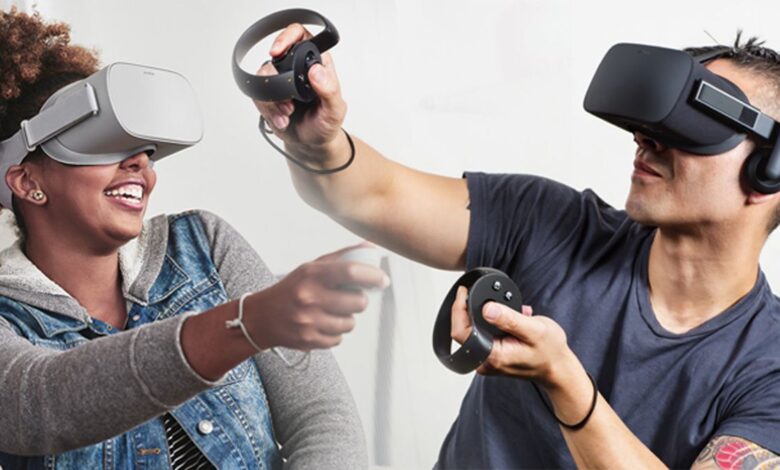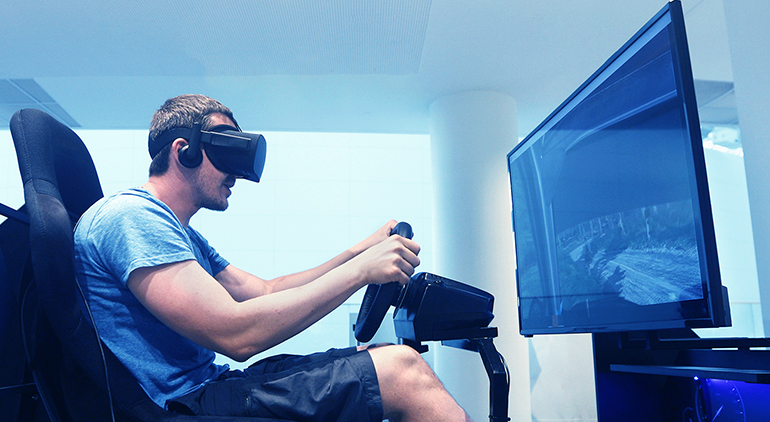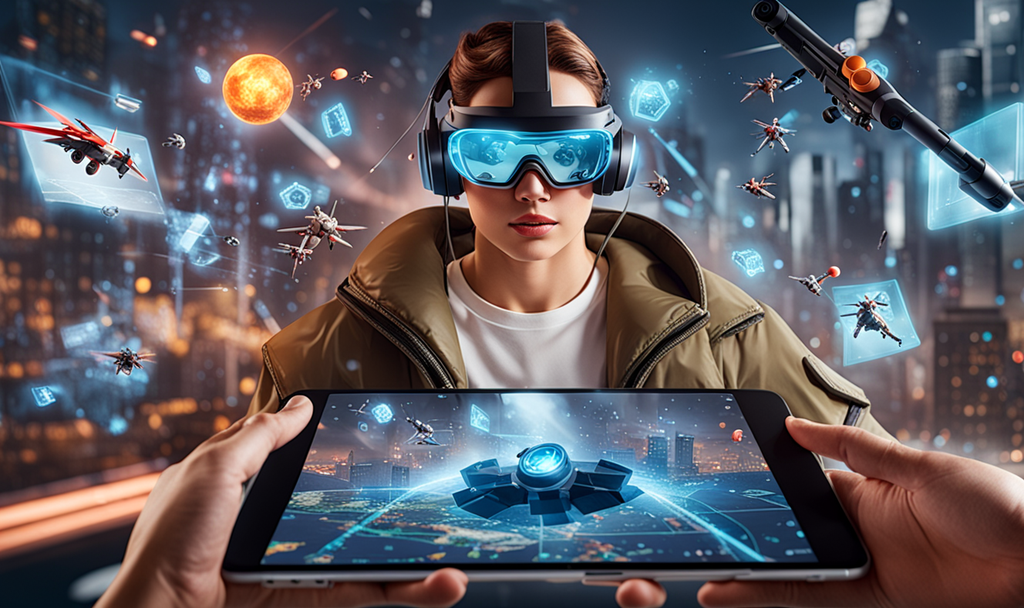Virtual and Augmented Gaming: The Glasses Revolution

For decades, the idea of stepping inside a video game—not just observing it on a screen—has been the ultimate fantasy of interactive entertainment.
That fantasy is rapidly solidifying into reality, not through clunky, tethered headsets of the past, but through sleek, powerful, and increasingly accessible Virtual Reality (VR) and Augmented Reality (AR) glasses.
These devices represent more than just a new display technology; they are fundamentally transforming the relationship between the player, the game world, and reality itself.
The conventional flat screen is yielding its dominance to immersive optics, turning every living room, park bench, and office space into a dynamic, personalized gaming arena.
This shift signals a departure from purely looking at a game to actively being in it. It moves us past abstract button-presses and toward intuitive, natural interaction—where our hands, our voice, and our physical movements become the direct means of control.
The adoption of these visual technologies is poised to introduce an unprecedented level of immersion, changing not only how we play, but also who plays and where they choose to do it.
I. The Technological Foundation: Fusing Reality

The current generation of VR and AR glasses has solved many of the critical problems that hindered earlier iterations, making the technology viable for mass consumption. The core advancement lies in optimizing visual fidelity, reducing friction, and achieving true independence.
The Defining Characteristics of Modern Optics
While often grouped together, VR and AR rely on distinct technological approaches to achieve immersion, each with unique applications in gaming.
A. Virtual Reality (VR): Complete Immersion
VR glasses offer a complete sensory blackout from the real world, replacing the user’s view with a fully simulated, three-dimensional digital environment.
- A. High Fidelity Displays: Modern VR utilizes high-resolution, fast-refresh-rate displays (measured in Pixels Per Degree, or PPD) to deliver sharp, detailed images close to the eye, drastically reducing the “screen-door effect” that plagued earlier generations.
- B. Low Latency Tracking: Advanced inside-out tracking (using external cameras on the headset itself) monitors the headset’s position and orientation in real space with near-zero latency. This precision is vital in preventing motion sickness and ensuring the simulated world responds instantly to the user’s physical movement.
- C. Ergonomics and Comfort: The trend toward tetherless, all-in-one headsets has made the experience vastly more comfortable and portable, removing the bulky wires and external sensors that restricted movement.
B. Augmented Reality (AR): Seamless Overlay
AR glasses utilize transparent lenses or pass-through cameras to overlay digital information, objects, and characters onto the user’s existing view of the real world.
- A. Real-World Integration: AR gaming excels at anchoring digital content to specific real-world locations or surfaces. A virtual city builder can be played on your coffee table, or a digital monster battle can erupt in your backyard.
- B. Spatial Awareness: Advanced AR optics use sensors to understand the geometry and depth of the physical environment, allowing digital objects to realistically occlude (be hidden behind) real objects, making the augmented experience seamless and convincing.
- C. Subtle Interaction: AR often relies on passive, subtle input, such as gaze tracking or simple hand gestures, blending the interface naturally into the physical environment without demanding specialized controllers.
The Processing Leap: From PC to Chip
The ability to deliver high-quality VR and AR without relying on an expensive, high-end PC is the single greatest catalyst for mass adoption.
- A. Dedicated System-on-a-Chip (SoC): Companies are developing custom mobile processors (SoCs) optimized specifically for spatial computing, balancing intense graphical rendering with the low-power requirements needed for portable headsets.
- B. Foveated Rendering: This sophisticated technique uses eye-tracking to determine precisely where the user is looking and only renders that specific area in full, sharp detail. The peripheral vision is rendered at a lower resolution, drastically reducing the computational load while maintaining the illusion of high fidelity across the entire field of view. This efficiency is crucial for untethered devices.
- C. Cloud Rendering Integration: For the most graphically demanding experiences, glasses will increasingly utilize cloud gaming infrastructure, streaming complex rendering tasks to the device, effectively offering PC-level graphics on a small, portable headset.
II. The Redefinition of Gameplay and Interaction
The unique capabilities of VR and AR fundamentally change the language of game design, emphasizing natural human behaviors over abstract inputs.
The Shift to Natural Interaction
A. Full-Body and Natural Locomotion
VR gaming moves beyond walking with a joystick to encouraging physical movement.
- A. Hand Presence: Controllers are designed not just for buttons, but for tracking individual finger movements, allowing players to naturally reach out, grasp, throw, and manipulate virtual objects with their hands, creating true hand presence.
- B. Physical Dodge and Cover: In action games, crouching behind a barricade or dodging a projectile requires the player to physically move their body, adding immense immersion and a layer of physical exertion to the experience.
- C. Spatial Puzzles: Games can leverage the full 3D space, requiring players to physically examine an object from all angles, walk around obstacles, or even peer over ledges to solve puzzles.
B. Mixed Reality (MR) and Environmental Blending
The convergence of VR and AR, often termed Mixed Reality (MR), allows the player to incorporate the real world into the game design itself.
- A. Safety and Boundaries: MR allows a VR game to render a view of the real environment when the player approaches a wall or furniture, preventing accidents while maintaining immersion.
- B. Real-World Interfaces: A player in a VR experience could use a physical keyboard or drink from a real cup that is tracked and rendered accurately within the virtual space, maintaining continuity with their real-world environment.
- C. Dynamic Boundaries: AR gaming turns the player’s physical space into the playing field. The size and shape of the living room dictate the size and layout of the virtual battlefield, making every session unique and context-aware.
C. Gaze, Voice, and Intention Input
The most subtle, yet powerful, input revolution is the use of the player’s natural biological cues.
- A. Voice as a Tool: Voice commands are used for complex interactions, such as commanding troops in a strategy game, casting verbal spells in an RPG, or managing inventory without breaking the flow of action.
- B. Foveated Interaction: Using eye-tracking, a player can simply look at a sign or an item to initiate a digital pop-up description or menu, making the UI nearly invisible until needed.
- C. Emotional Biometrics: Future systems may integrate tracking of pupil dilation, heart rate, or facial expressions to gauge the player’s emotional state (fear, stress, surprise) and dynamically adjust the game’s difficulty or atmospheric tension accordingly.
III. The New Ecosystems of Gaming and Consumption

The shift to spatial glasses is not just about technology; it’s about establishing entirely new digital storefronts, content pipelines, and social norms for gaming.
The Social and Economic Transformation
A. Multiplayer and the Social Metaverse
VR and AR glasses are the keys to unlocking a truly social metaverse, where physical distance is irrelevant.
- A. Realistic Presence: Headset tracking allows for incredibly realistic avatar movement, including head nods, hand gestures, and body language, making virtual interactions feel far more genuine than traditional text chat or voice communication.
- B. Shared Physical Space: AR allows groups of friends to play the same game in the same physical room, with everyone seeing the same augmented creatures or objects overlaid on their shared real environment.
- C. Persistent Digital Worlds: AR games can leave persistent digital content anchored to real-world locations (e.g., a virtual mural at a public park, a hidden treasure marker), encouraging real-world exploration and community formation.
B. Content Creation and Democratization
The tools for creating spatial content are becoming easier and more accessible, democratizing game development further.
- A. Drag-and-Drop Builders: New engines and tools allow designers to prototype VR/AR experiences by physically moving and placing virtual objects within the virtual space, accelerating the design process without requiring specialized coding knowledge.
- B. User-Generated Content (UGC): Platforms focusing on VR and AR are rapidly growing, allowing average users to design and share unique environments, mini-games, and social spaces, creating a constantly refreshing content library.
- C. Interactive Advertising: AR allows for games to integrate highly contextual and interactive advertisements, such as a virtual car model appearing on the floor of a player’s real garage, opening up new revenue streams for developers.
C. The Subscription and Hybrid Model
The initial high cost of high-end glasses makes a subscription or hybrid revenue model the most likely path for content consumption.
- A. Hardware-as-a-Service: Consumers might pay a monthly fee that covers both the latest headset hardware (which is periodically upgraded) and access to a rotating library of VR/AR content.
- B. Micro-Immersion: Instead of long, sprawling games, AR may favor highly focused, short-burst, location-aware “micro-immersion” experiences, perfect for a quick game during a commute or break.
- C. Enterprise Overlap: Gaming profits will increasingly overlap with enterprise applications (training, design, simulation) as the core technology becomes unified, cross-subsidizing the hardware costs.
IV. Overcoming the Final Hurdles to Universal Adoption
Despite the immense promise, the widespread adoption of VR and AR glasses still hinges on overcoming several technological and cultural barriers.
The Three Critical Challenges
A. The Form Factor and Aesthetics
The physical design of the glasses remains a key obstacle for daily use.
- A. Weight and Bulk: Current VR headsets, while far improved, are still relatively heavy and bulky, limiting comfortable playtime to a few hours and making them impractical for use outside the home.
- B. Social Acceptance: AR glasses need to become sleek, lightweight, and indistinguishable from regular eyewear before the average consumer is willing to wear them publicly for extended periods. This requires massive advancements in miniaturization and battery technology.
- C. Battery Life: The immense processing power required for real-time spatial computing drains batteries rapidly. Achieving all-day battery life in a slim form factor remains one of the largest engineering challenges.
B. The Comfort and Health Continuum
Even with low latency, certain experiences can still cause discomfort for some users.
- A. Motion Sickness Mitigation: Although vastly improved, some types of artificial movement (like sliding rapidly in a virtual environment while the player’s real body is static) can still trigger nausea in sensitive individuals. Designers must continue to innovate with comfort-first locomotion techniques.
- B. Eye Strain and Focus: The technology required to correctly render images at varying depths (vergence-accommodation conflict) must be perfected to prevent eye strain during long gaming sessions.
- C. Reality Disturbance: AR requires the user’s brain to constantly reconcile the physical world with the digital overlay, which can be cognitively demanding until the technology becomes perfectly seamless.
C. The Content and Discovery Pipeline
Mass adoption requires a consistent stream of high-quality, compelling, system-selling content that cannot be replicated on a traditional screen.
- A. The Killer App: The industry needs several definitive VR/AR titles that are so essential they drive mainstream consumers to purchase the hardware (analogous to Halo for Xbox or Wii Sports for Wii).
- B. Curation and Quality: As content creation becomes easier, the challenge shifts to curating and highlighting the best experiences from the rapidly expanding volume of available games, preventing user fatigue and disappointment.
V. Conclusion
The journey of gaming from the arcade cabinet to the television screen and now into our immediate field of vision represents the medium’s relentless pursuit of immersion.
The transition to gaming with VR/AR glasses is not a speculative future; it is an inevitable step driven by the maturity of mobile processors, spatial tracking algorithms, and consumer demand for richer, more natural interactive experiences.
The greatest impact of this glasses revolution lies in its ability to destroy the last remaining screen barrier. VR and AR introduce the dimension of presence—the genuine, subconscious feeling of being there.
This shifts the core value of a game away from abstract graphics and toward authentic, physical interaction. When a player must physically duck to avoid an attack or reach out to grasp a virtual key, the experience moves beyond entertainment and becomes a truly visceral memory.
Furthermore, AR gaming will usher in the era of ambient interactivity. Imagine a world where game environments aren’t contained within a box but flow seamlessly through daily life.
Your morning run becomes a quest; your commute involves hunting down digital collectibles; and your coffee break is spent building a virtual tower that only you and your friends can see on the park bench.
This continuous, low-friction presence of digital play in the physical world will expand the definition of gamer to include virtually everyone who owns a pair of smart glasses.
The immediate future will see the VR and AR markets diverge before eventually merging into true Mixed Reality (MR) glasses—devices light enough for all-day wear that can instantly switch between a complete virtual blackout and a seamless augmented overlay.
As these glasses become aesthetically indistinguishable from ordinary eyewear and the content library reaches critical mass, the specialized gaming computer or console will increasingly become an optional component, reserved for only the most dedicated enthusiasts.
The universal, hands-free, personalized gaming screen is arriving, promising a world where the only limitation on the game is the boundary of our own imagination.